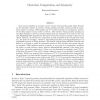Free Online Productivity Tools
i2Speak
i2Symbol
i2OCR
iTex2Img
iWeb2Print
iWeb2Shot
i2Type
iPdf2Split
iPdf2Merge
i2Bopomofo
i2Arabic
i2Style
i2Image
i2PDF
iLatex2Rtf
Sci2ools
BIRTHDAY
2010
Springer
2010
Springer
Choiceless Computation and Symmetry
Many natural problems in computer science concern structures like graphs where elements are not inherently ordered. In contrast, Turing machines and other common models of computation operate on strings. While graphs may be encoded as strings (via an adjacency matrix), the encoding imposes a linear order on vertices. This enables a Turing machine operating on encodings of graphs to choose an arbitrary element from any nonempty set of vertices at low cost (the Augmenting Paths algorithm for Bipartite Matching being an example of the power of choice). However, the outcome of a computation is liable to depend on the external linear order (i.e., the choice of encoding). Moreover, isomorphism-invariance/encoding-independence is an undecidable property of Turing machines. This trouble with encodings led Blass, Gurevich and Shelah [3] to propose a model of computation known as BGS machines that operate directly on structures. BGS machines preserve symmetry at every step in a computation, sac...
Related Content
| Added | 08 Nov 2010 |
| Updated | 08 Nov 2010 |
| Type | Conference |
| Year | 2010 |
| Where | BIRTHDAY |
| Authors | Benjamin Rossman |
Comments (0)

